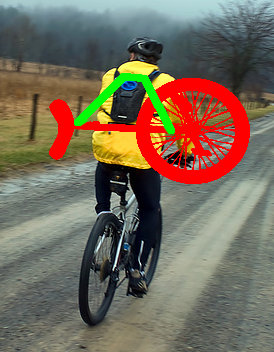document updated 14 years ago, on Jun 27, 2011
Three wheels, no hands

Overview
There are three main pieces to this:
- a backpack (hopefully well-padded)
- vertical support — a rope that goes from the top of the backpack to the unicycle, that is the main load-bearing component (shown in the diagram in green) It should be tied to the unicycle fork on one end, and the seatpost on the other.
- horizontal support — a rope that goes around the front of your body, across your belly/belt line, to keep the unicycle stable, to prevent it from rotating in various ways
Tips

unicycle pedal position
You'll want to tie one of the unicycle's crank arms to its fork, to prevent the unicycle wheel from spinning. And then turn the unicycle so that the tied-crank side faces away from your back (this positions the pedal on the towards-your-back side so that it's as far out as possible, so it doesn't poke into your back).
The rope around your belly needs to be VERY tight, because there's a lot of core-body-motion when you pedal. I eventually had to use a trucker's hitch to get it tight enough.
Before riding, walk around with the unicycle strapped on, to check for proper fit. If the unicycle wiggles down to below your belt, and ESPECIALLY if it falls below your tailbone, then you need to readjust the vertical-support so it rests higher. Otherwise, when you're riding, you'll find yourself constantly pulling the unicycle back onto your back, and waiting for the thing to slide down your butt again.
Upsides of this solution
- Compared to other possible unicycle-bike-rack solutions, this is easy to put together last-minute, if you know a few knots. It took me five minutes to put the entire thing together the first time, without preparation.
- This works on any bike, including ones without a bike rack.
- When you get off the bike and lock it up, the unicycle stays attached to you, not the bike. This may be more convenient, depending on what you plan to do after lock-up.
Downsides of this solution
The main issue is that you're almost twice as wide in the bike lane as you normally are. The unicycle really has to sit sideways, otherwise it would drag on the bike's rear wheel. This isn't a huge deal (bikes aren't very wide as-is), but you still had to keep it in mind in some situations:
- In urban bike-commuting, I found myself taking the lane more often.
- In rush-hour traffic where cars weren't moving at all, I had to stop and tip-toe past close mirrors that I would have otherwise zoomed through.
- And the clincher, which means it's not suitable for long-term use: If someone ever tries to door you, you have to swerve farther out into the car lane to avoid the door than you normally would.
- Also, if you walk around with the unicycle after getting off the bike, you take up more than half the sidewalk, so it might bother a few oncoming pedestrians if the sidewalk is crowded.
Future exploration
I plan to try tying the unicycle to the bike rack once I get one. That should fix the biggest downside of this.


